Laura E. Barnes
A computational framework for longitudinal medication adherence prediction in breast cancer survivors: A social cognitive theory based approach
Apr 20, 2025Abstract:Non-adherence to medications is a critical concern since nearly half of patients with chronic illnesses do not follow their prescribed medication regimens, leading to increased mortality, costs, and preventable human distress. Amongst stage 0-3 breast cancer survivors, adherence to long-term adjuvant endocrine therapy (i.e., Tamoxifen and aromatase inhibitors) is associated with a significant increase in recurrence-free survival. This work aims to develop multi-scale models of medication adherence to understand the significance of different factors influencing adherence across varying time frames. We introduce a computational framework guided by Social Cognitive Theory for multi-scale (daily and weekly) modeling of longitudinal medication adherence. Our models employ both dynamic medication-taking patterns in the recent past (dynamic factors) as well as less frequently changing factors (static factors) for adherence prediction. Additionally, we assess the significance of various factors in influencing adherence behavior across different time scales. Our models outperform traditional machine learning counterparts in both daily and weekly tasks in terms of both accuracy and specificity. Daily models achieved an accuracy of 87.25%, and weekly models, an accuracy of 76.04%. Notably, dynamic past medication-taking patterns prove most valuable for predicting daily adherence, while a combination of dynamic and static factors is significant for macro-level weekly adherence patterns.
A Shape-Based Functional Index for Objective Assessment of Pediatric Motor Function
Jan 02, 2025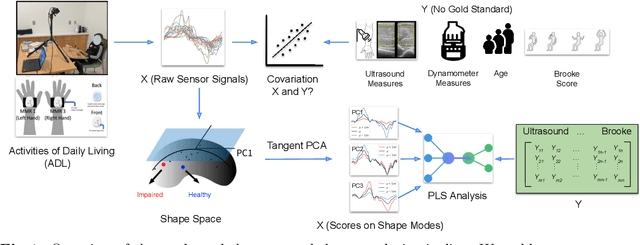
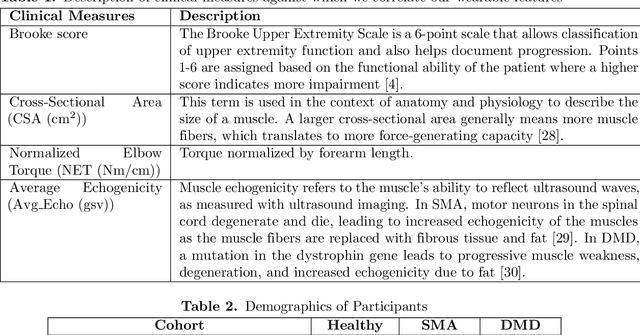


Abstract:Clinical assessments for neuromuscular disorders, such as Spinal Muscular Atrophy (SMA) and Duchenne Muscular Dystrophy (DMD), continue to rely on subjective measures to monitor treatment response and disease progression. We introduce a novel method using wearable sensors to objectively assess motor function during daily activities in 19 patients with DMD, 9 with SMA, and 13 age-matched controls. Pediatric movement data is complex due to confounding factors such as limb length variations in growing children and variability in movement speed. Our approach uses Shape-based Principal Component Analysis to align movement trajectories and identify distinct kinematic patterns, including variations in motion speed and asymmetry. Both DMD and SMA cohorts have individuals with motor function on par with healthy controls. Notably, patients with SMA showed greater activation of the motion asymmetry pattern. We further combined projections on these principal components with partial least squares (PLS) to identify a covariation mode with a canonical correlation of r = 0.78 (95% CI: [0.34, 0.94]) with muscle fat infiltration, the Brooke score (a motor function score), and age-related degenerative changes, proposing a novel motor function index. This data-driven method can be deployed in home settings, enabling better longitudinal tracking of treatment efficacy for children with neuromuscular disorders.
AudioInsight: Detecting Social Contexts Relevant to Social Anxiety from Speech
Jul 19, 2024

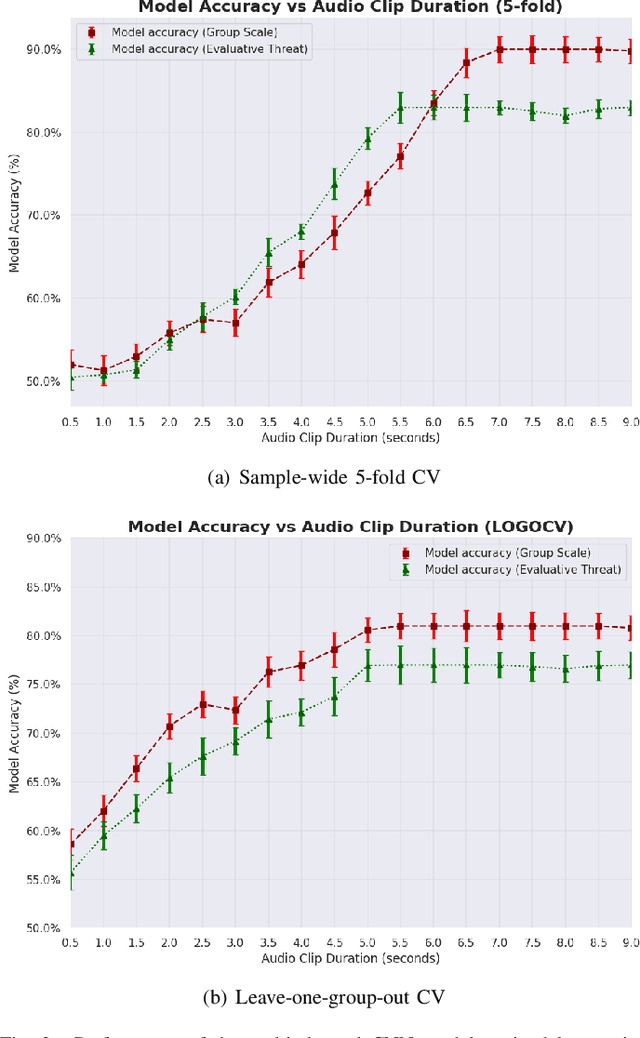
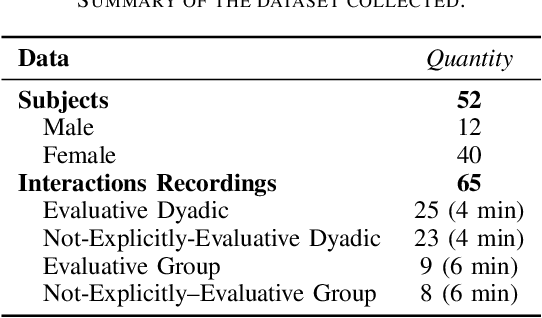
Abstract:During social interactions, understanding the intricacies of the context can be vital, particularly for socially anxious individuals. While previous research has found that the presence of a social interaction can be detected from ambient audio, the nuances within social contexts, which influence how anxiety provoking interactions are, remain largely unexplored. As an alternative to traditional, burdensome methods like self-report, this study presents a novel approach that harnesses ambient audio segments to detect social threat contexts. We focus on two key dimensions: number of interaction partners (dyadic vs. group) and degree of evaluative threat (explicitly evaluative vs. not explicitly evaluative). Building on data from a Zoom-based social interaction study (N=52 college students, of whom the majority N=45 are socially anxious), we employ deep learning methods to achieve strong detection performance. Under sample-wide 5-fold Cross Validation (CV), our model distinguished dyadic from group interactions with 90\% accuracy and detected evaluative threat at 83\%. Using a leave-one-group-out CV, accuracies were 82\% and 77\%, respectively. While our data are based on virtual interactions due to pandemic constraints, our method has the potential to extend to diverse real-world settings. This research underscores the potential of passive sensing and AI to differentiate intricate social contexts, and may ultimately advance the ability of context-aware digital interventions to offer personalized mental health support.
Converging Paradigms: The Synergy of Symbolic and Connectionist AI in LLM-Empowered Autonomous Agents
Jul 11, 2024



Abstract:This article explores the convergence of connectionist and symbolic artificial intelligence (AI), from historical debates to contemporary advancements. Traditionally considered distinct paradigms, connectionist AI focuses on neural networks, while symbolic AI emphasizes symbolic representation and logic. Recent advancements in large language models (LLMs), exemplified by ChatGPT and GPT-4, highlight the potential of connectionist architectures in handling human language as a form of symbols. The study argues that LLM-empowered Autonomous Agents (LAAs) embody this paradigm convergence. By utilizing LLMs for text-based knowledge modeling and representation, LAAs integrate neuro-symbolic AI principles, showcasing enhanced reasoning and decision-making capabilities. Comparing LAAs with Knowledge Graphs within the neuro-symbolic AI theme highlights the unique strengths of LAAs in mimicking human-like reasoning processes, scaling effectively with large datasets, and leveraging in-context samples without explicit re-training. The research underscores promising avenues in neuro-vector-symbolic integration, instructional encoding, and implicit reasoning, aimed at further enhancing LAA capabilities. By exploring the progression of neuro-symbolic AI and proposing future research trajectories, this work advances the understanding and development of AI technologies.
Incremental Semi-supervised Federated Learning for Health Inference via Mobile Sensing
Dec 19, 2023Abstract:Mobile sensing appears as a promising solution for health inference problem (e.g., influenza-like symptom recognition) by leveraging diverse smart sensors to capture fine-grained information about human behaviors and ambient contexts. Centralized training of machine learning models can place mobile users' sensitive information under privacy risks due to data breach and misexploitation. Federated Learning (FL) enables mobile devices to collaboratively learn global models without the exposure of local private data. However, there are challenges of on-device FL deployment using mobile sensing: 1) long-term and continuously collected mobile sensing data may exhibit domain shifts as sensing objects (e.g. humans) have varying behaviors as a result of internal and/or external stimulus; 2) model retraining using all available data may increase computation and memory burden; and 3) the sparsity of annotated crowd-sourced data causes supervised FL to lack robustness. In this work, we propose FedMobile, an incremental semi-supervised federated learning algorithm, to train models semi-supervisedly and incrementally in a decentralized online fashion. We evaluate FedMobile using a real-world mobile sensing dataset for influenza-like symptom recognition. Our empirical results show that FedMobile-trained models achieve the best results in comparison to the selected baseline methods.
Personalized State Anxiety Detection: An Empirical Study with Linguistic Biomarkers and A Machine Learning Pipeline
Apr 19, 2023Abstract:Individuals high in social anxiety symptoms often exhibit elevated state anxiety in social situations. Research has shown it is possible to detect state anxiety by leveraging digital biomarkers and machine learning techniques. However, most existing work trains models on an entire group of participants, failing to capture individual differences in their psychological and behavioral responses to social contexts. To address this concern, in Study 1, we collected linguistic data from N=35 high socially anxious participants in a variety of social contexts, finding that digital linguistic biomarkers significantly differ between evaluative vs. non-evaluative social contexts and between individuals having different trait psychological symptoms, suggesting the likely importance of personalized approaches to detect state anxiety. In Study 2, we used the same data and results from Study 1 to model a multilayer personalized machine learning pipeline to detect state anxiety that considers contextual and individual differences. This personalized model outperformed the baseline F1-score by 28.0%. Results suggest that state anxiety can be more accurately detected with personalized machine learning approaches, and that linguistic biomarkers hold promise for identifying periods of state anxiety in an unobtrusive way.
Wearable Sensor-based Multimodal Physiological Responses of Socially Anxious Individuals across Social Contexts
Apr 03, 2023

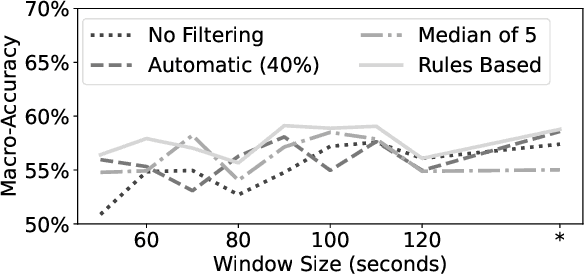
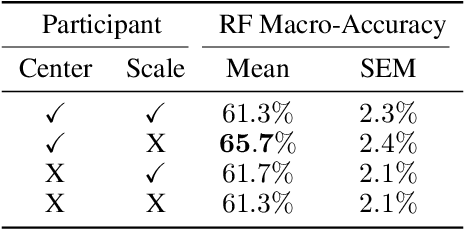
Abstract:Correctly identifying an individual's social context from passively worn sensors holds promise for delivering just-in-time adaptive interventions (JITAIs) to treat social anxiety disorder. In this study, we present results using passively collected data from a within-subject experiment that assessed physiological response across different social contexts (i.e, alone vs. with others), social phases (i.e., pre- and post-interaction vs. during an interaction), social interaction sizes (i.e., dyadic vs. group interactions), and levels of social threat (i.e., implicit vs. explicit social evaluation). Participants in the study ($N=46$) reported moderate to severe social anxiety symptoms as assessed by the Social Interaction Anxiety Scale ($\geq$34 out of 80). Univariate paired difference tests, multivariate random forest models, and follow-up cluster analyses were used to explore physiological response patterns across different social and non-social contexts. Our results suggest that social context is more reliably distinguishable than social phase, group size, or level of social threat, but that there is considerable variability in physiological response patterns even among these distinguishable contexts. Implications for real-world context detection and deployment of JITAIs are discussed.
Graph Neural Networks in IoT: A Survey
Mar 31, 2022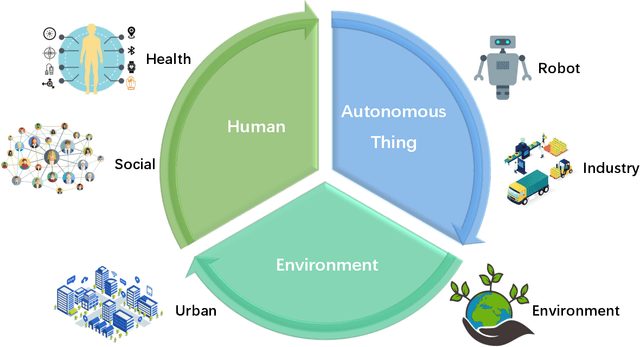
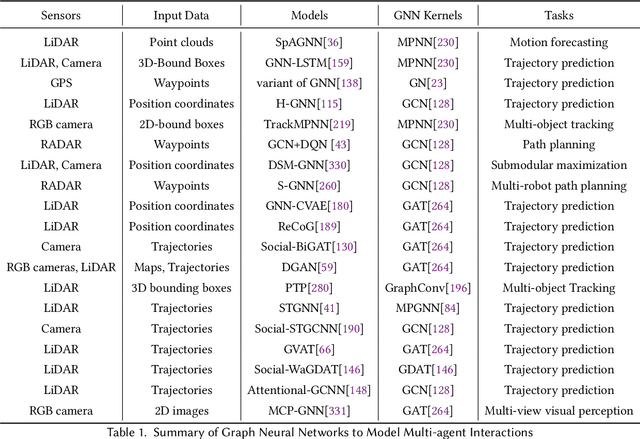

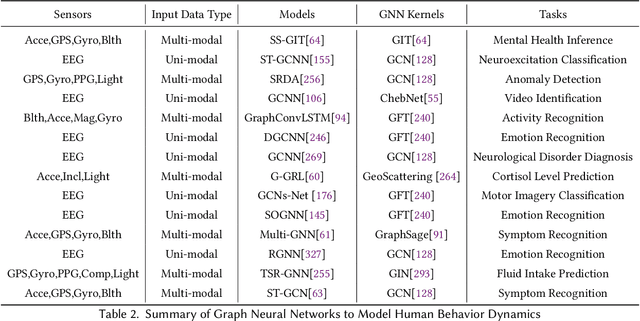
Abstract:The Internet of Things (IoT) boom has revolutionized almost every corner of people's daily lives: healthcare, home, transportation, manufacturing, supply chain, and so on. With the recent development of sensor and communication technologies, IoT devices including smart wearables, cameras, smartwatches, and autonomous vehicles can accurately measure and perceive their surrounding environment. Continuous sensing generates massive amounts of data and presents challenges for machine learning. Deep learning models (e.g., convolution neural networks and recurrent neural networks) have been extensively employed in solving IoT tasks by learning patterns from multi-modal sensory data. Graph Neural Networks (GNNs), an emerging and fast-growing family of neural network models, can capture complex interactions within sensor topology and have been demonstrated to achieve state-of-the-art results in numerous IoT learning tasks. In this survey, we present a comprehensive review of recent advances in the application of GNNs to the IoT field, including a deep dive analysis of GNN design in various IoT sensing environments, an overarching list of public data and source code from the collected publications, and future research directions. To keep track of newly published works, we collect representative papers and their open-source implementations and create a Github repository at https://github.com/GuiminDong/GNN4IoT.
Improving mathematical questioning in teacher training
Dec 06, 2021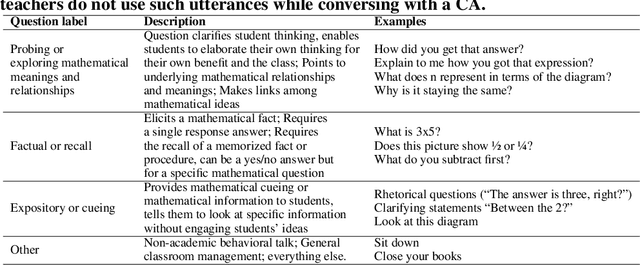

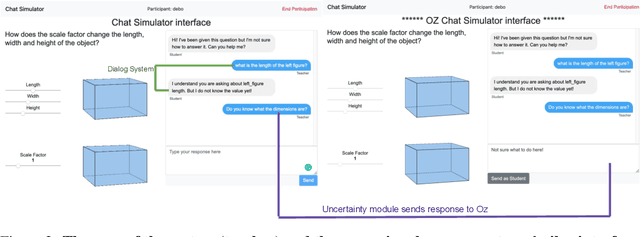
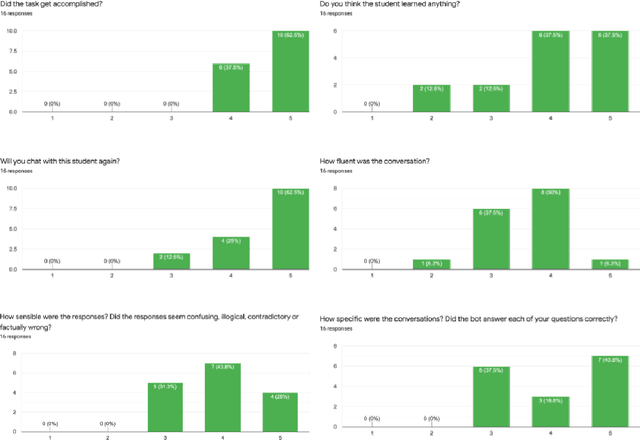
Abstract:High-fidelity, AI-based simulated classroom systems enable teachers to rehearse effective teaching strategies. However, dialogue-oriented open-ended conversations such as teaching a student about scale factors can be difficult to model. This paper builds a text-based interactive conversational agent to help teachers practice mathematical questioning skills based on the well-known Instructional Quality Assessment. We take a human-centered approach to designing our system, relying on advances in deep learning, uncertainty quantification, and natural language processing while acknowledging the limitations of conversational agents for specific pedagogical needs. Using experts' input directly during the simulation, we demonstrate how conversation success rate and high user satisfaction can be achieved.
Evaluation of mathematical questioning strategies using data collected through weak supervision
Dec 02, 2021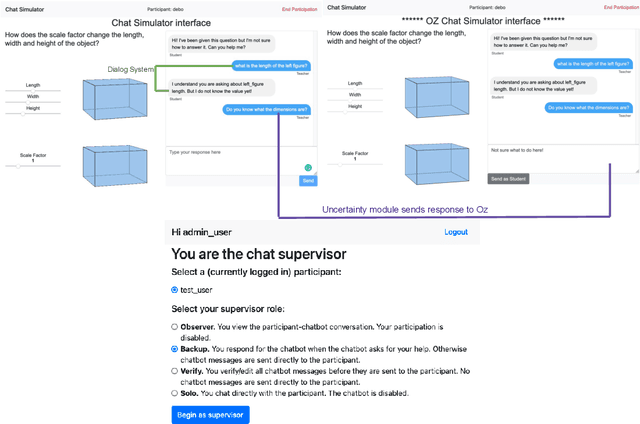
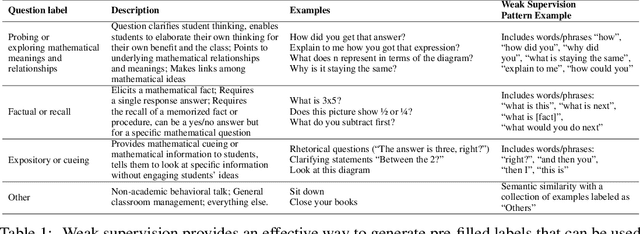


Abstract:A large body of research demonstrates how teachers' questioning strategies can improve student learning outcomes. However, developing new scenarios is challenging because of the lack of training data for a specific scenario and the costs associated with labeling. This paper presents a high-fidelity, AI-based classroom simulator to help teachers rehearse research-based mathematical questioning skills. Using a human-in-the-loop approach, we collected a high-quality training dataset for a mathematical questioning scenario. Using recent advances in uncertainty quantification, we evaluated our conversational agent for usability and analyzed the practicality of incorporating a human-in-the-loop approach for data collection and system evaluation for a mathematical questioning scenario.
 Add to Chrome
Add to Chrome Add to Firefox
Add to Firefox Add to Edge
Add to Edge